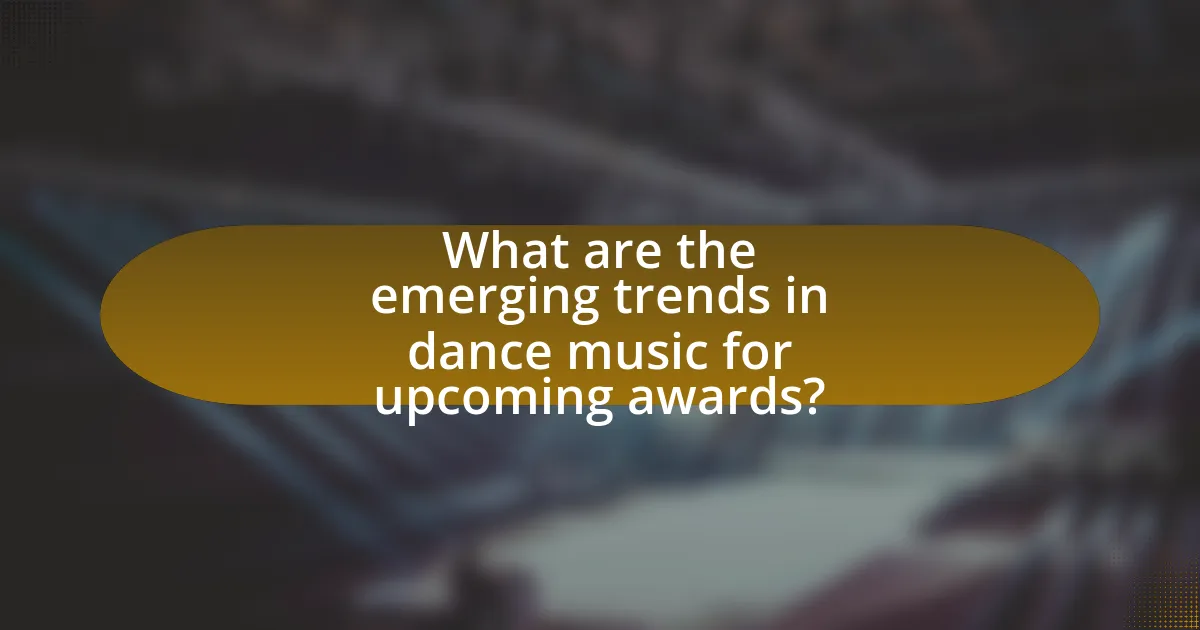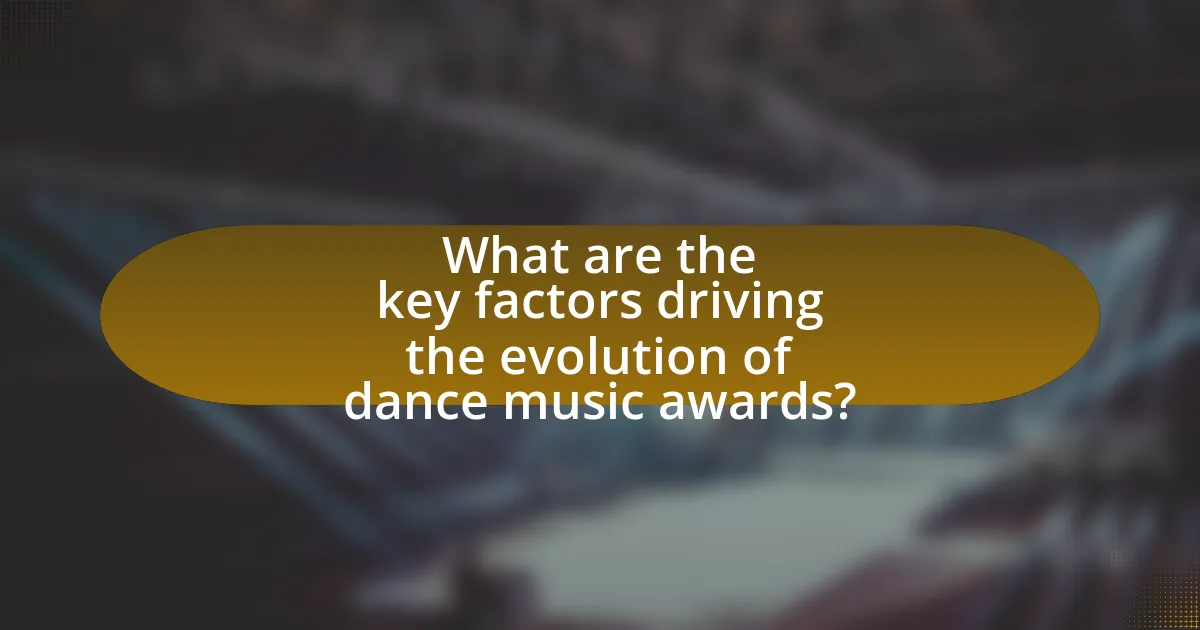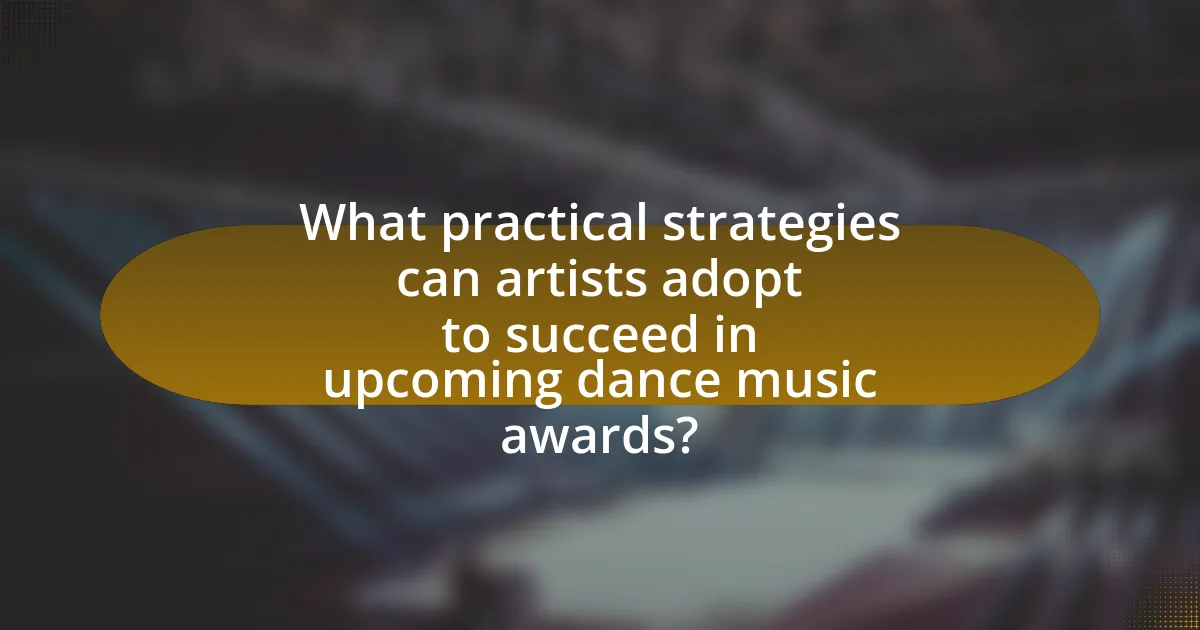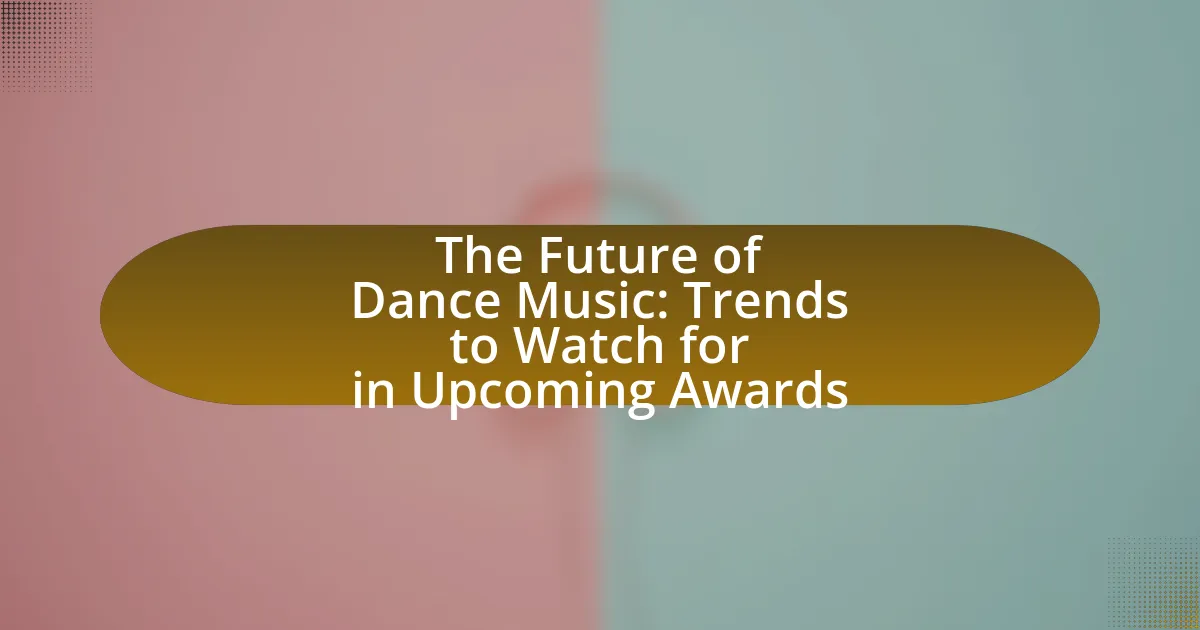The article focuses on the future of dance music and the emerging trends that are expected to influence upcoming awards. Key trends include the rise of genre-blending tracks, the integration of artificial intelligence in music production, and a growing emphasis on sustainability in live events. Additionally, technological advancements and the impact of streaming platforms are reshaping how music is produced and recognized. The article also highlights the importance of cultural shifts, social movements, and diversity in shaping the dance music scene, as well as practical strategies for artists to enhance their chances of success in award nominations.

What are the emerging trends in dance music for upcoming awards?
Emerging trends in dance music for upcoming awards include the rise of genre-blending tracks, increased use of artificial intelligence in music production, and a focus on sustainability in live events. Genre-blending tracks, which combine elements from various styles such as house, techno, and pop, are gaining popularity, reflecting the evolving tastes of listeners. The integration of artificial intelligence is transforming how music is created, with AI tools assisting artists in composing and producing tracks, leading to innovative sounds. Additionally, the dance music industry is increasingly prioritizing sustainability, with many artists and event organizers committing to eco-friendly practices, which resonates with the growing environmental consciousness among fans. These trends are shaping the landscape of dance music and influencing nominations and awards in the industry.
How are technological advancements influencing dance music trends?
Technological advancements are significantly influencing dance music trends by enabling innovative production techniques and enhancing live performances. Digital audio workstations (DAWs) and software synthesizers allow producers to create complex sounds and arrangements that were previously unattainable, leading to the emergence of new sub-genres like future bass and trap. Additionally, advancements in hardware, such as MIDI controllers and DJ equipment, facilitate more dynamic and interactive live shows, which attract larger audiences. For instance, the integration of visual technology, like LED screens and projection mapping, has transformed performances into immersive experiences, further shaping audience expectations and preferences in dance music.
What role do streaming platforms play in shaping dance music recognition?
Streaming platforms significantly influence dance music recognition by providing widespread access to tracks and facilitating artist discovery. These platforms, such as Spotify and Apple Music, utilize algorithms that promote popular tracks and emerging artists, thereby shaping listener preferences and trends. For instance, Spotify’s curated playlists, like “Mint” for dance music, have been instrumental in elevating tracks to mainstream success, evidenced by the fact that songs featured on these playlists often see substantial increases in streams and chart performance. This accessibility and promotion enable artists to reach global audiences, ultimately impacting their recognition in award shows and industry accolades.
How is artificial intelligence being utilized in dance music production?
Artificial intelligence is utilized in dance music production primarily through algorithmic composition, sound design, and mixing automation. AI tools analyze vast datasets of existing music to generate new melodies, harmonies, and rhythms that align with popular trends in dance music. For instance, platforms like AIVA and Amper Music leverage machine learning to create original tracks based on user-defined parameters, enabling producers to experiment with unique sounds efficiently. Additionally, AI-driven software can assist in mixing by automatically adjusting levels and applying effects, streamlining the production process and enhancing sound quality. This integration of AI not only accelerates creativity but also allows producers to focus on artistic expression while relying on technology for technical tasks.
What cultural shifts are impacting the dance music scene?
Cultural shifts impacting the dance music scene include the rise of social media platforms, which have transformed how artists promote their music and engage with fans. This shift has led to a democratization of music distribution, allowing independent artists to gain visibility without traditional label support. Additionally, the increasing emphasis on inclusivity and diversity within the scene has prompted festivals and events to prioritize representation, reflecting broader societal movements for equality. For instance, the inclusion of more female and non-binary artists on lineups has become a focal point, as seen in major festivals like Coachella and Tomorrowland, which have made concerted efforts to balance gender representation. These cultural changes are reshaping the landscape of dance music, influencing both the production and consumption of the genre.
How are social movements reflected in dance music themes?
Social movements are reflected in dance music themes through the incorporation of social justice, political activism, and cultural identity into lyrics and sound. For instance, the rise of house music in the 1980s was closely tied to the LGBTQ+ rights movement, with tracks often celebrating freedom and self-expression. Additionally, contemporary artists like Black Lives Matter advocate for racial equality through their music, using platforms to address systemic issues. The themes of empowerment and resistance resonate in tracks that address climate change, gender equality, and anti-racism, demonstrating how dance music serves as a vehicle for social commentary and collective action.
What influence does global diversity have on dance music styles?
Global diversity significantly influences dance music styles by introducing a variety of rhythms, instruments, and cultural elements from different regions. This fusion creates unique sub-genres, such as Afrobeat-infused house music or Latin-inspired electronic dance music, which reflect the cultural backgrounds of their origins. For instance, the incorporation of traditional African drumming patterns into electronic music has led to the rise of genres like Afro-house, showcasing how global influences can reshape soundscapes. Additionally, the accessibility of digital platforms allows artists from diverse backgrounds to collaborate and share their music globally, further enriching the dance music scene.
Why is collaboration becoming more prevalent in dance music?
Collaboration is becoming more prevalent in dance music due to the increasing demand for diverse sounds and the blending of genres. This trend is driven by the rise of digital platforms that facilitate easy communication and sharing among artists, allowing them to reach wider audiences. Additionally, collaborations often lead to innovative tracks that combine different styles, appealing to fans of multiple genres. The success of collaborative projects, such as the 2020 hit “Head & Heart” by Joel Corry and MNEK, demonstrates how partnerships can create chart-topping music that resonates with listeners, further encouraging artists to work together.
What are the benefits of cross-genre collaborations in dance music?
Cross-genre collaborations in dance music enhance creativity and broaden audience reach. By merging different musical styles, artists can innovate and produce unique sounds that attract diverse listeners. For instance, collaborations between electronic dance music (EDM) and hip-hop artists have led to chart-topping hits, demonstrating the commercial viability of such partnerships. Additionally, these collaborations often result in increased streaming numbers and festival bookings, as they tap into the fan bases of both genres, exemplified by the success of tracks like “Despacito” remixed with EDM elements. This blending of genres not only revitalizes the music but also fosters a more inclusive music culture.
How do collaborations affect award nominations and wins?
Collaborations significantly enhance award nominations and wins by combining the strengths and fan bases of multiple artists. This synergy often leads to increased visibility and broader appeal, making collaborative works more likely to resonate with voters and audiences. For instance, high-profile collaborations in the music industry, such as those between artists like Calvin Harris and Dua Lipa, have resulted in multiple award nominations and wins, as their combined popularity attracts attention from both fans and critics alike. Additionally, collaborations can introduce innovative sounds and styles, further increasing the likelihood of recognition in award circuits, as seen in the Grammy Awards, where collaborative tracks frequently dominate nomination categories.

What are the key factors driving the evolution of dance music awards?
The key factors driving the evolution of dance music awards include technological advancements, changing audience demographics, and the globalization of music culture. Technological advancements, such as streaming platforms and social media, have transformed how music is consumed and promoted, leading to increased visibility for artists and awards. Changing audience demographics, particularly the rise of younger listeners who engage with music differently, influence award categories and voting processes. Additionally, the globalization of music culture allows for a broader range of genres and artists to be recognized, reflecting diverse influences and trends in dance music. These factors collectively shape the landscape of dance music awards, making them more inclusive and relevant to contemporary audiences.
How do industry standards influence award categories in dance music?
Industry standards significantly shape award categories in dance music by establishing criteria that reflect current trends, technological advancements, and audience preferences. These standards often dictate the recognition of specific genres, production techniques, and artist contributions, ensuring that awards remain relevant and reflective of the evolving landscape. For instance, the rise of electronic sub-genres like future bass or deep house has led to the creation of specialized categories in major awards, such as the Grammy Awards, which now include Best Dance/Electronic Album and Best Dance Recording. This evolution demonstrates how industry standards adapt to the changing dynamics of the music scene, promoting diversity and innovation within the dance music genre.
What new categories are being introduced in dance music awards?
New categories being introduced in dance music awards include Best Virtual Performance, Best Music Video for a Dance Track, and Best Collaboration with a Non-Dance Artist. These categories reflect the evolving landscape of the dance music industry, acknowledging the impact of technology and cross-genre collaborations. The inclusion of Best Virtual Performance highlights the rise of online events, especially during the pandemic, while Best Music Video for a Dance Track recognizes the importance of visual storytelling in music promotion.
How are voting processes changing for dance music awards?
Voting processes for dance music awards are increasingly incorporating digital platforms and blockchain technology to enhance transparency and accessibility. These changes allow fans to participate more easily in the voting process, often through mobile apps or online portals, which can lead to higher engagement and a more diverse voter base. For instance, the integration of blockchain ensures that votes are securely recorded and verifiable, reducing the risk of fraud and manipulation. This shift reflects a broader trend in the music industry towards leveraging technology to empower fans and create a more democratic voting environment.
What role do fan engagement and social media play in dance music awards?
Fan engagement and social media are crucial in dance music awards as they enhance visibility and participation. Social media platforms allow fans to vote, share their opinions, and promote their favorite artists, creating a sense of community and excitement around the awards. For instance, platforms like Twitter and Instagram have been used to facilitate real-time voting and engagement, significantly increasing the awards’ reach and interaction levels. According to a study by the International Music Summit, 70% of fans reported that social media influenced their voting decisions in music awards, highlighting its impact on fan involvement and the overall success of the event.
How can artists leverage social media to boost their chances at awards?
Artists can leverage social media by actively engaging with their audience and promoting their work, which increases visibility and fan support, crucial for award nominations. For instance, platforms like Instagram and TikTok allow artists to share behind-the-scenes content, music snippets, and personal stories, fostering a deeper connection with fans. This engagement can lead to increased streaming numbers and social media interactions, both of which are often considered by award committees. Additionally, artists can collaborate with influencers to reach wider audiences, enhancing their chances of being recognized in award circuits.
What impact does fan voting have on award outcomes?
Fan voting significantly influences award outcomes by allowing the audience to directly participate in the selection process, which can shift the results towards more popular or commercially successful nominees. This democratization of the voting process often leads to a greater representation of fan-favorite artists, as seen in various music awards where public votes can outweigh industry votes. For instance, in the American Music Awards, fan voting accounts for a substantial portion of the final tally, reflecting the preferences of the general public rather than just industry insiders. This trend highlights the growing importance of fan engagement in shaping award results, particularly in genres like dance music, where community support can propel artists to recognition.
Why is the representation of diverse artists important in dance music awards?
The representation of diverse artists in dance music awards is crucial for fostering inclusivity and reflecting the genre’s broad cultural spectrum. Diverse representation ensures that various voices and experiences are acknowledged, which can lead to a richer and more innovative music landscape. For instance, studies show that diversity in artistic representation can enhance creativity and audience engagement, as seen in the increased popularity of genres like Afrobeat and Latin music within the dance music scene. Furthermore, awards that celebrate diverse artists can challenge industry norms and inspire upcoming musicians from underrepresented backgrounds, ultimately contributing to a more equitable music industry.
How are awards addressing gender and racial diversity in nominations?
Awards are increasingly implementing measures to enhance gender and racial diversity in nominations. Many organizations are establishing diversity quotas and guidelines to ensure that underrepresented groups are included in the nomination process. For instance, the Recording Academy, which oversees the Grammy Awards, has introduced initiatives aimed at increasing the representation of women and people of color among nominees and winners. In 2021, the Academy reported that 34% of nominees in the top categories were women, a significant increase from previous years. Additionally, various awards are conducting audits of their nomination processes to identify and address biases, thereby promoting a more equitable representation of diverse artists in the dance music genre.
What initiatives are being taken to support underrepresented artists?
Initiatives to support underrepresented artists include funding programs, mentorship opportunities, and dedicated platforms for showcasing their work. Organizations such as the National Endowment for the Arts provide grants specifically aimed at artists from marginalized communities, ensuring they have access to resources that promote their creative expression. Additionally, festivals and award shows are increasingly implementing diversity initiatives, such as the inclusion of panels and showcases that highlight underrepresented voices in dance music, thereby fostering a more inclusive environment.

What practical strategies can artists adopt to succeed in upcoming dance music awards?
Artists can succeed in upcoming dance music awards by focusing on building a strong online presence, engaging with their audience, and collaborating with other artists. A robust online presence, including active social media engagement and a professional website, allows artists to showcase their work and connect with fans, which is crucial for visibility in a competitive industry. Engaging with the audience through live streams, Q&A sessions, and behind-the-scenes content fosters a loyal fan base, increasing the likelihood of support during voting periods. Collaborating with other artists can expand reach and introduce new audiences, as seen in successful partnerships that have led to award nominations. These strategies are supported by the fact that artists with higher social media engagement and collaborative projects often see increased recognition and success in award nominations.
How can artists effectively promote their work for award consideration?
Artists can effectively promote their work for award consideration by leveraging social media platforms, engaging with industry influencers, and submitting to relevant competitions. Social media allows artists to showcase their work to a broad audience, increasing visibility and engagement; for instance, platforms like Instagram and TikTok have been pivotal in the careers of many musicians. Engaging with industry influencers can lead to endorsements or collaborations that enhance credibility and reach; research shows that 70% of consumers are influenced by recommendations from peers and influencers. Additionally, submitting work to competitions that align with their genre and style increases the chances of recognition, as many awards have specific criteria that artists can meet to stand out.
What marketing techniques are most effective for dance music artists?
Social media marketing is the most effective technique for dance music artists. Platforms like Instagram, TikTok, and Facebook allow artists to engage directly with fans, share content, and promote events. For instance, TikTok has become a powerful tool for music discovery, with tracks going viral and leading to increased streams and downloads. According to a report by the International Music Summit, 70% of dance music artists attribute their success to social media engagement, highlighting its critical role in building a fanbase and promoting releases.
How important is networking within the industry for award success?
Networking within the industry is crucial for award success. Strong connections can lead to increased visibility, collaboration opportunities, and endorsements from influential figures, all of which enhance a candidate’s chances of recognition. For instance, a study by the National Endowment for the Arts found that artists with robust professional networks are more likely to receive awards and funding, highlighting the direct correlation between networking and success in competitive environments.
What are the best practices for submitting music for awards?
The best practices for submitting music for awards include understanding the submission guidelines, ensuring high-quality recordings, and providing a compelling artist biography. Adhering to specific requirements set by the award organization is crucial, as failure to comply can result in disqualification. High-quality recordings enhance the listening experience and increase the chances of being noticed by judges. Additionally, a well-crafted artist biography that highlights achievements and unique aspects of the music can create a stronger impression. These practices are supported by industry standards, which emphasize the importance of professionalism and attention to detail in award submissions.
What common mistakes should artists avoid when submitting for awards?
Artists should avoid submitting work that does not align with the award’s criteria. Many artists fail to thoroughly read the submission guidelines, leading to disqualification or rejection. For instance, submitting a genre-specific piece to a general award can demonstrate a lack of understanding of the award’s focus. Additionally, artists often overlook the importance of high-quality presentation; poorly produced audio or visual materials can detract from the perceived value of their work. According to a survey by the National Endowment for the Arts, 70% of submissions that lacked attention to detail were rejected. Lastly, missing deadlines is a frequent mistake; timely submissions are crucial, as many awards have strict cut-off dates.
How can artists ensure their submissions stand out to judges?
Artists can ensure their submissions stand out to judges by showcasing originality and technical proficiency in their work. Originality captures judges’ attention, as unique concepts and innovative approaches differentiate submissions from the competition. Technical proficiency demonstrates skill and mastery of the craft, which judges often prioritize when evaluating submissions.
For instance, a study by the National Endowment for the Arts highlights that originality and technical skill are key factors influencing the success of artistic submissions in competitive environments. By focusing on these elements, artists can create compelling submissions that resonate with judges and increase their chances of recognition in awards related to dance music.
What resources are available for artists preparing for dance music awards?
Artists preparing for dance music awards can access various resources, including industry workshops, online courses, and networking events. Workshops often focus on enhancing performance skills, understanding award criteria, and marketing strategies, while online courses provide in-depth knowledge about music production and promotion. Networking events allow artists to connect with industry professionals, which can lead to collaborations and increased visibility. Additionally, platforms like SoundCloud and Beatport offer promotional tools and analytics to help artists gauge their audience and improve their chances of recognition.
What organizations provide support and guidance for dance music artists?
Organizations that provide support and guidance for dance music artists include the Association for Electronic Music (AFEM), which advocates for the interests of electronic music creators and businesses, and the International Dance Music Awards (IDMAs), which recognize and promote excellence in the dance music industry. Additionally, the American Society of Composers, Authors and Publishers (ASCAP) offers resources and networking opportunities for music creators, while the Performing Rights Society (PRS) for Music provides support in terms of royalties and copyright protection. These organizations play a crucial role in fostering the growth and development of dance music artists by offering various forms of assistance, including legal advice, industry insights, and promotional opportunities.
How can artists access funding or sponsorship for their projects?
Artists can access funding or sponsorship for their projects through various channels such as grants, crowdfunding platforms, and corporate sponsorships. Grants are often provided by arts councils, foundations, and government agencies that support creative projects, with specific eligibility criteria and application processes. Crowdfunding platforms like Kickstarter and Indiegogo allow artists to present their projects to the public and receive financial support directly from individuals. Additionally, corporate sponsorships can be pursued by aligning artistic projects with brands that share similar values or target audiences, often resulting in financial backing or in-kind support. These methods are validated by the increasing number of successful projects funded through these avenues, demonstrating their effectiveness in the arts community.
